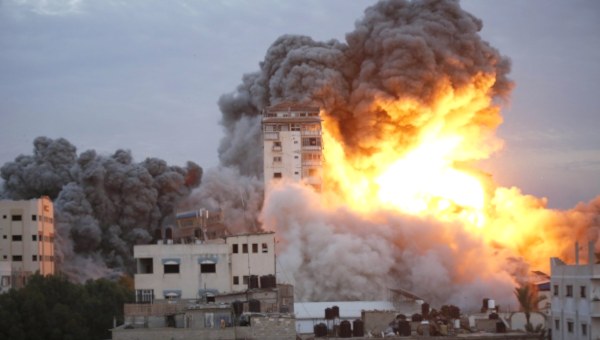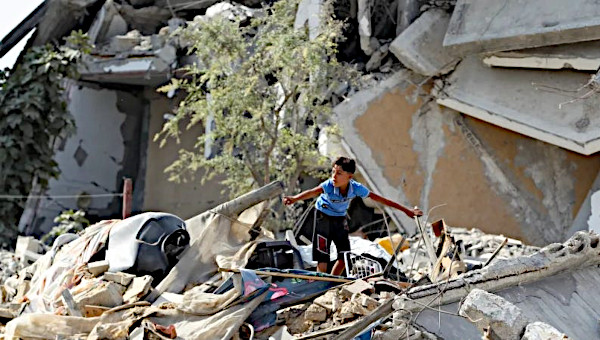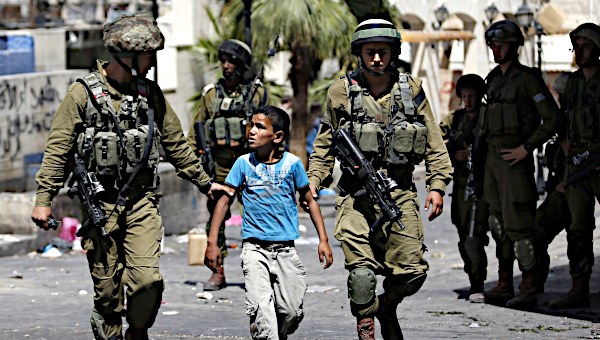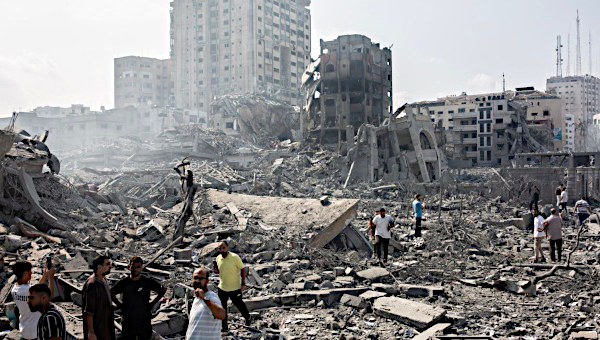Psychological Complexities of Violence and Revenge
Preventing recurrent, predictable catastrophes must come with eliminating its causes, including complex, unequivalent psychological motives for revenge and violence. Unlike the Holocaust defense of “not knowing,” people in Israel and defenders of Israel cannot claim ignorance about Israel’s scorched earth wars on a captive civilian population. Almost all Jewish Israelis serve in the military, and upwards of 90% repeatedly support these wars. There is plenty of public knowledge about Israel’s brutal treatment of Palestinians.
Albert Einstein, Hannah Arendt et al. in a 1948 letter to the New York Times: “Among the most disturbing political phenomena of our times is the emergence in the newly created state of Israel of the ‘Freedom Party’ (Tnuat Haherut), a political party closely akin in its organization, methods, political philosophy and social appeal to the Nazi and Fascist parties.”
Ad published in Ha’aretz on 22 September 1967: “Our right to defend ourselves from extermination does not give us the right to oppress others. Occupation entails foreign rule… Repression entails terror and counter-terror. The victims of terror are mostly innocent people. Holding on to the occupied territories will turn us into a nation of murderers and murder victims…”

Constant Danger
The Olga Appeal signed in 2004 by over 100 prominent Israeli Jews: “The State of Israel was supposed to grant security to Jews; it has created a death-trap whose inhabitants live in constant danger, the likes of which is not experienced by any other Jewish community. The State of Israel was supposed to tear down the walls of the ghetto; it is now constructing the biggest ghetto in the entire history of the Jews; The State of Israel was supposed to be a democracy; it has set up a colonial structure, combining unmistakable elements of apartheid with the arbitrariness of brutal military occupation…”
Daniel Barenboim, born in Argentina to Jewish Russian parents, concert pianist, close friend and colleague of Edward Said, declared in his 2004 speech to the Knesset on receiving the Wolf Prize:
“The Declaration of Independence was a source of inspiration to believe in ideals that transformed us from Jews to Israelis. This remarkable document expressed the commitment: ‘The state of Israel will devote itself to the development of this country for the benefit of all its people…’ I am asking today with deep sorrow: Can we, despite all our achievements, ignore the intolerable gap between what the Declaration of Independence promised and what was fulfilled, the gap between the idea and the realities of Israel? … Can the Jewish people whose history is a record of continued suffering and relentless persecution, allow themselves to be indifferent to the rights and suffering of a neighboring people?”
The answer is obvious: “Yes.”
Benzi Sanders posted a video on social media of a 19-year-old survivor of the Hamas massacre at kibbutz Be’eri. She is enraged, terrified, and sorrowful about what happened to her and her close friends. She said that this one night of horror is what Palestinians in Gaza suffer every day. She blames the heavily militarized Israeli government.
Israel’s New Historians document the fact that mass expulsion and assassination was carefully planned before the Holocaust. What followed the Nakba was the Occupation, the recurrent deployment of unconventional and prohibited weapons, the use of the most lethal advanced technology against a captive population, and disproportionate killing, incarceration, and torture of Palestinian children.
The clash between ideal and reality is a product of individual and group psychology interacting with political power. Jewish and Palestinian violence and revenge have different psychological causes.
Shakespeare’s Shylock says: “and if you wrong us shall we not revenge? … If a Jew wrong a Christian, what is his humility? Revenge. If a Christian wrong a Jew, what should his sufferance be by Christian example? Why, revenge.”
In late 2008, I presented a paper at the Gaza Community Mental Health Program (GCMHP)/World Health Organization meeting “Building Bridges, Not Walls,” tragically followed by Israel’s Operation Cast Lead total war on Gaza. I quoted a Palestinian psychiatrist and an Israeli Jewish mother who had lost her daughter to a Palestinian suicide terrorist attack. The late Dr. Eyad El-Sarraj, director of the GCMHP:1
“‘For many of these children (in Gaza) the most excruciating ordeal was to see their fathers being beaten by Israeli soldiers – and not offering any resistance. This is truly a terrifying experience… This will have a lasting impact on any observer, but particularly on children. No wonder the Palestinian child will see his model not in his father, but in that soldier; and no wonder his language will be the language of force and his toys and games the toys and games of death.’ He wrote that those children ‘were subjected to several traumatic and violent experiences including beating, bone-breaking, injury, tear gas and acts of killing and injury, all of which experiences have left indelible effects on their psyche. Yet, to many, the most excruciating experience was seeing their fathers beaten helpless by Israeli soldiers without resistance’.”
Dr. Nurit Peled-Elhanan talked about the daily humiliation of Palestinian mothers in front of their children: “I have never experienced the suffering Palestinian women undergo every day, every hour. I don’t know the kind of violence that turns a woman’s life into constant hell. This daily physical and mental torture of women who are deprived of their basic human rights and needs of privacy and dignity, women whose homes are broken into at any moment of day and night.”
Israeli smugness and triumphalism are widely disseminated in photos of Israelis sitting on lawn chairs in Sderot overlooking Gaza, entertained by unconventional weapons exploding over Gazan schools and neighborhoods. How do the victims of slaughter react to these images?
Psychology and Victimhood
Psychologically, there are various reactions to being victimized. Even after excruciating experiences, people can maintain their sense that people are still human, not subhuman monsters or animals, elements or numbers, nobodies, collateral. Or defensively, they may react to wrongdoing by doing to others what was done to them, coping with the experience by turning a passive experience into an active one by being the perpetrator and not the victim. They can feel entitled and justified to be an exception to rules and morality because of being wronged. They can identify with the aggressor as described above by Dr. El-Sarraj.2
In his brilliant documentary, Israeli filmmaker Avi Mograbi shows how Israeli youth are indoctrinated from toddlerhood through young adulthood with the ideal of Samson the Hero. Samson was the Israelite judge who lost his mythic strength when Delilah cut his hair. He was subsequently captured and imprisoned by the Philistines and chained to the pillars of a temple. God restored Samson’s strength, and he pulled down the temple in an act of suicidal murder, killing 5000 worshippers. In the most startling scene, Mograbi shows youth indoctrinated at Masada where long ago heroic Jews under siege and surveillance chose to jump to their death. Asked how they would react to these conditions, the majority smilingly and heroically said they would leap to their death. Yet they failed to make the connection of this siege with the brutal siege and surveillance of Gaza.
Theodor Herzl, the author of Zionism in the late 19th century efflorescence of nationalism, wrote that his ideals were the German soldier and American cowboy. Modern Israel extols the ideal of strength and militarism and scorns weakness. This is evident in the many descriptions that can be found of Israel’s disdainful, discriminatory treatment of caricatured weak ghetto Jews, of Holocaust survivors.3
Three Examples
Strategic lies conceal surreptitious provocations to violence, as if the causes are endemic antisemitism against innocent Israel that justify massive retaliation with total impunity. First example from Noam Chomsky:
“Just one day before, Israel kidnapped two civilians in Gaza – a far worse crime than capturing a soldier – and transported them to Israel (in violation of international law, but that is routine), where they presumably joined the roughly one thousand prisoners held by Israel without charges, hence kidnapped.” He writes about the flat rejection of “Hamas’s call for a long-term cease-fire to allow for negotiations in terms of the international consensus on a two-state settlement…”4
Henry Siegman is the former director of the American Jewish Council and former Senior Fellow of the Council of Foreign Relations. He authored “Israel’s Lies” about Israel’s 2009 Operation Cast Lead and the lies that were disseminated: “that Hamas consistently violated the six-month truce that Israel observed and then refused to extend it; that Israel therefore had no choice but to destroy Hamas’s capacity to launch missiles into Israeli towns; that Hamas is a terrorist organisation, part of a global jihadi network…” Siegman continued: “Middle East peacemaking has been smothered in deceptive euphemisms, so let me state bluntly that each of these claims is a lie. Israel, not Hamas, violated the truce: Hamas undertook to stop firing rockets into Israel; in return, Israel was to ease its throttlehold on Gaza. In fact, during the truce, it tightened it further… It cannot be said that Israel launched its assault to protect its citizens from rockets. It did so to protect its right to continue the strangulation of Gaza’s population.”
Another example of such misinformation is about how the murder by Palestinians of three Israeli youth in the West Bank was intentionally committed to provoke a Jewish vengeful terrorist act against Palestinians. Ben Ehrenreich describes the 2014 Palestinian murder of three Israeli youth in the West Bank. At first, there was a gag order on all news connected with this killing as if there was still time to save these youth. The following day, Netanyahu blamed Hamas for kidnapping the teenagers. For weeks, he continued to repeat, without any evidence, the same message about terrorist Hamas. 700,000 Palestinian inhabitants of Hebron were sealed off, and the IDF raided every major city in the West Bank, killing and imprisoning Palestinians. “The media whipped the Israeli public into a frenzy of anxiety and rage,” and “Bring Back Our Boys” appeared everywhere with open talk about a collective punishment of “cleansing the stables.” The government and media secretly knew of the murder. The IDF perpetrated massive brutalities during this fabricated ‘search’. Mobs carried signs emblazoned with “Revenge.” A Palestinian teen named Mohammad Abu Khdeir was martyred: the autopsy found soot in his lungs, bronchi, and throat – he was burned alive.5
Is surreptitious provocation, like killing Iranian nuclear physicists and Iranian general Qassem Soleimani, a frightening strategy used to provoke Iranian retaliation that would then justify Israeli retaliation?
Ambiguity about Israel’s well-documented possession of nuclear weapons allows plausible deniability about its nuclear arsenal. When asked about Israeli nuclearism, Obama infamously said “I don’t want to speculate.” Nation states and the UN collude with this claim of innocence: the US State Department reportedly banned officials from using terms of “de-escalation and ceasefire.” Just this month, the UN Security Council voted against calling for a ceasefire. A deployment of a de-militarized peacekeeping force was never considered.
There is a huge, glaring dichotomy between image and reality: the self-representation of Jewish universal values, a light unto nations, the people of the book, “Never again” for all people, the hypocrisy of atonement. The aforementioned Olga Appeal concludes:
“We are talking of a road that has not been tried hitherto: being honest with ourselves, with our neighbours and particularly with the Palestinian people. If we muster within ourselves the appropriate honesty and requisite courage, we will be able to take the first step in the long journey that can extricate us from the tangle of denial, repression, distortion of reality, loss of direction and forsaking of conscience, in which the people of Israel have been trapped for generations.” •
Endnotes
- Judith Deutsch, “Psychoanalytic thoughts on Israel and the siege of Gaza,” in Psychoanalysis, Collective Traumas and Memory Places, 2008, ed. S. Varvin, W. Bohleber, R. Hinshelwood, Giuseppe Leo. Frenis Zero Press, Italy.
- Sigmund Freud describes the belief in entitlement, of being an exception, in his article “Some character-types met with in psychoanalytic work (1916),” Standard Edition XIV. Also see Anna Freud’s excellent chapter “Identification with the Aggressor,” p. 109-121, in The Ego and the Mechanisms of Defense. 1937 (1971).
- For example, see Haim Bresheeth-Zabner, An Army Like No Other: How the Israel Defence Forces Made a Nation. Verso, New York. 2020. Norman Finkelstein’s work on image vs reality, Avi Shlaim’s Three Worlds: memoirs of an Arab-Jew. Simon and Shuster, 2023. Also see Pappé’s Ethnic Cleansing of Palestine.
- Noam Chomsky and Ilan Pappé, Gaza in Crisis: Reflections on US-Israeli War On the Palestinians, Haymarket Books, Chicago, 2010. p. 6.
- Ben Ehrenreich, The Way to the Spring: Life and death in Palestine, Penguin Books, New York, 2016. p. 327 ff.





